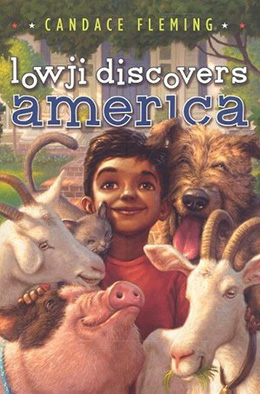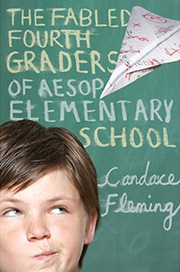BOOKS

Aladdin, 2008
978–1‑416–95832‑1
ages 9 and up
buy the book
paperback
After you’ve read Lowji Discovers America, try this book:
Lowji Discovers America
Dear Jamshed,
America is not so different from what we thought. I told you I wouldn’t see a single cowboy riding across the plain, and I haven’t. I have not even seen a plain. Still, there are some silver linings. They are:
1. Trapper and King, the cat and dog who live in the apartment building. They are cuddly and waggy. I am not allowed to play with them, though, because they are supposed to catch mice and keep burglars away.
2. Ironman. He owns a pig and talks to me a lot. But he is a grown-up.
3. Kids. I can hear them playing outside. Too bad they do not want to play with me.
I wish you were here. Do you wish I was in India?
Write back soon.
Your friend,
Lowji
Resources
- Lowji Discovers America Classroom Guide
Reviews
“To be honest, I am more than a little sad,” says nine-year-old Lowji after he moves with his parents from Bombay to an apartment in tiny Hamlet, Illinois. It’s summer, the local kids are hard to meet, and Lowji longs for a pet to keep him company. Then he cleverly persuades crotchety, overworked landlady Crisp that animals could help with the chores. Soon the building is home to a cat that keeps mice under control, a dog that substitutes for a burglar alarm, and goats that keep the grass short. Delighted, Lowji helps care for the menagerie of pets and, in the process, begins to form new neighborhood friendships. Details about Indian culture (an appended glossary defines terms) and Lowji’s Zoroastrian religion are purposefully inserted, as are a few moments when Lowji finds common ground with his new neighbors. But, through Lowji’s mostly age-appropriate voice, Fleming tells a gentle, effective story about the loneliness and bewilderment that come with moving, and her brisk, lively sentences make this a good choice for readers gaining confidence with chapter books. (Gillian Engberg, Booklist)
“The versatile Fleming has written a refreshingly light novel about a boy from Bombay who moves to a small town in Illinois at the beginning of summer vacation, so he’s faced with no friends and nothing to do. Before long, though, he persuades his grouchy landlady to adopt a succession of animals (first a cat, then a dog, and finally a goat), rescues a pet pig that belongs to a very sweet tough guy, and wistfully watches a mysterious girl on a blue bicycle pass by his apartment. Told in first person in Lowji’s slightly formal yet engaging voice, the story has a simple charm that glides over some well-worn comic territory (how often has a goat munched on a ruffled shirt stolen from a clothes line?). Interspersed throughout are letters to the boy’s best friend in India, which show his gradual transition into his new world. Similar in tone to a classic like Henry Huggins, this book is nevertheless firmly set in the 21st century and opens a window to what may be an unfamiliar culture to many readers. The episodic structure lends itself to classroom or family read-alouds.” (Lauralyn Persson, School Library Journal)
“Lowji has lived in Bombay with his Ma and Bape for his whole life. He loves his life in the big city in his modern high-rise apartment building, but he does not like one of the rules: NO PETS. When his mother gets a high-tech job in suburban Illinois, he moves away from his best friend, his school and his grandparents. Though he’s disappointed to find that apartment rules are much the same anywhere, Lowji, always looking for the silver lining, comes up with a plan that leads to the addition of a working cat (for the mice) and dog (to discourage burglars) and even some goats (to mow the grass). There’s nothing stereotypical about this family-the mother has the high-tech job and the father will find a job as a chef someday. Many interesting details of Indian food, clothes and culture are sprinkled comfortably through the story, including a discussion of the tenets of Zoroastrianism and Hinduism. This early-chapter book introduces a likable, lively boy, and readers will wonder how he fares in American schools. Let’s hope for a sequel or two.” (Kirkus Reviews)


